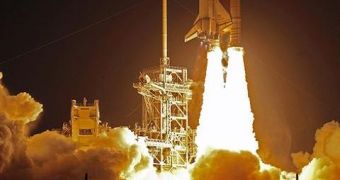The seven crew members aboard the STS-119 Discovery mission, which successfully launched yesterday evening from the Kennedy Space Center in Florida, will inspect the heat shield on their shuttle for any signs of damage on Monday. They are scheduled to dock on the International Space Station tomorrow, and they have to ensure that everything is set for their return home, two weeks from now.
For this task, the crew will use what is called an “inspection pole,” a long tool filled with sensors, capable of detecting any anomalies that might have occurred on the surface of the craft's heat shield. They will inspect both the wings as well as the nose section of Discovery, so as to avoid any incidents once their return to the KSC. The inspection will begin at 2:28 pm EDT (1828 GMT), and is just the first of a series of observations meant to assess the shuttle's thin, tiled shield.
“We didn't see anything at all in the first quick look. It looked pretty clean,” Bill Gerstenmaier, who is the chief of space operations at the NASA American space agency, revealed after the launch. He said that the procedures including the in-flight monitoring had been a standard requirement for all shuttle missions, ever since the Columbia disaster, when the craft was lost due to a shield failure upon the atmosphere re-entry procedure. It will take “about 5 1/2 to six hours of inspection work using our space shuttle robotic arm,” mission commander Lee Archambault, who is in charge of the STS-119 mission, stressed.
“The inspection has become somewhat standard now. We'll grab this boom out of the shuttle's payload bay. It's got sensors on the end, and we'll use those sensors to scan the leading edge and the nose are of the space shuttle to make sure we didn't sustain any damage from ascent,” Dominic Antonelli added before the lift-off. He is the pilot of the Discovery space shuttle for this mission.
“It's very tedious work and you're operating the inspection boom within very close proximity of the orbiter for an extended period of time. The idea here is not to let anyone get complacent and keep everyone focused on the job at hand,” Archambault stated, adding that all crew members would participate in the effort, so as to ease Antonelli's work. The pilot is also the lead robotic arm operator for the mission.
The crew aboard Discovery will assist the three members of the ISS Expedition 17 crew to set up the last array of solar panels on the orbital facility, and will replace NASA astronaut Sandra Magnus with JAXA expert Koichi Wakata. Over the 13 days of the mission, the joint teams will also perform three spacewalks, one less than the original number. The cut-back was necessary on account of the fact that the first launch date for the mission was delayed for more than a month, due to fuel valve-related issues.

 14 DAY TRIAL //
14 DAY TRIAL //